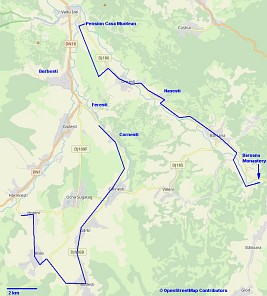Maramureş on Foot
(vero;2019-Nov-30)
Make sure to check our photo gallery for more pictures of Maramureş and its wooden churches.
We had a hard time deciding how to tour Maramureş and where to base ourselves. The region's main attraction are the wooden churches and they are scattered around a relatively large area, some being difficult to reach without a car. Public transport is not really an option as it is tailored to suit the local needs, most buses departing from the villages in the morning and returning in the afternoon or early evening; exactly the contrary of what we needed! Not to speak of week-ends when hardly any local bus is operating. So we were hesitating between the transport hub of Sighetu Marmaţiei or one of the many villages in the valleys.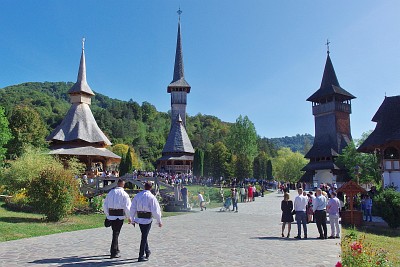
We quickly realised that we could not see everything and decided to concentrate on a defined area rather than rush from one place to the other. In the end we chose to stay in Vadu Izei, a village near Sighetu, located at the confluence of the Mara and Iza rivers and allowing direct access to both valleys. We booked a room at the Casa Muntean pension which we fully recommend, with friendly owners and free pick-up from Sighetu.
Bârsana Monastery and the Iza Valley
Our first day was a Sunday (with no local bus running) so we chose Bârsana in the Iza Valley for our first taste of Maramureş: 16 km road one-way, a 32 km hike worst case, just about doable in a long day. We started walking along the road with our thumbs up around 10 am and were immediately taken by a young couple, who as luck would have it, were also on their way to the monastery! Bârsana is very popular, it is a pilgrimage but also a tourist destination and on this Sunday it was quite busy with tourists and many locals who had come specifically to attend the 10:45 Sunday service.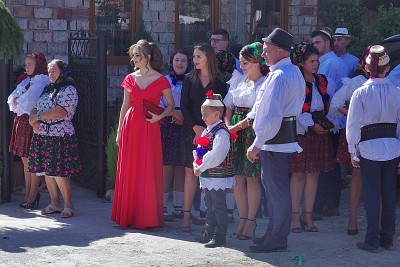
The monastery, built in 1993, is a modern construction and counts a dozen of wooden buildings and churches set on the slopes of a hill in the middle of a green landscape. Many locals, particularly women, come in their traditional dress to attend the service while men tend to wear dark trousers and immaculate white shirts. We stood around for a while with the rest of the crowd listening to the sermon and eventually started to wander around the compound. There is a small museum on-site with a collection of icons well worth seeing and a small shop selling handicraft made by the nuns.
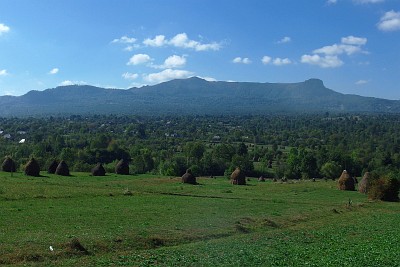 Since we wanted to walk all the way back to Vadu Izei, we left after about two hours and the main road being quite busy, crossed the river on a bridge opposite the monastery to follow some tracks on the other side. We regained the main road at the village of Bârsana and visited its old wooden church (inscribed on the UNESCO world heritage list).
Since we wanted to walk all the way back to Vadu Izei, we left after about two hours and the main road being quite busy, crossed the river on a bridge opposite the monastery to follow some tracks on the other side. We regained the main road at the village of Bârsana and visited its old wooden church (inscribed on the UNESCO world heritage list).
It was closed when we arrived but we were again lucky: a Romanian party came and a man phoned the key-keeper who arrived five minutes later and opened the church, our first exposure to the incredible frescoes hidden in nearly all the inconspicuous wooden churches of the region.
We continued our way partly following the main road and partly escaping on more or less parallel dirt roads until we reached the village of Năneşti where we came across a wedding with music, parading horses and many people in traditional attire, a great opportunity for people watching. We made our way through the upper village to avoid the road traffic: a very pleasant stroll past wooden houses and farms. Next stop was Onceşti where we had a break sitting on one of the benches which are lining the roads and streets of the villages. Each house has its own bench where the locals enjoy sitting, gossiping with neighbours and family, reading, knitting, peeling vegetables or simply watching the world go by. Just at the exit of Onceşti we followed a path on the right hand-side leading to a telecommunication mast: we climbed up the hill and ended on a plateau set between the Mara and Iza valleys where some cows were grazing lazily and which afforded great views of the surrounding area. We walked along this plateau until the path dropped down to the Iza valley shortly before Vadu Izei.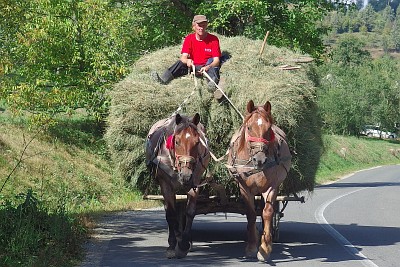
Hoteni, Breb, Budeşti and the Cosău Valley
Emboldened by our hitch-hiking experience of the previous day, we decided to try our luck on our second day: catch a lift to Harnicesti and from there walk a loop via Hoteni, Breb, Budeşti and back via the villages of the Cosău Valley, hoping again for a lift at some point in time to bring us back to Vadu Izei (see map above). We had to wait a bit longer but after about 10 minutes we were taken by a young man who happened to live in the village of Hoteni and dropped us there. We had a splendid day, walking along quiet country roads, the first part from Hoteni to Budeşti being particularly scenic as we crossed a hilly landscape with enticing views of the mountains of Creasta Cocoşului in the distance. We stopped en route in all villages, exploring their wooden churches, admiring the wooden gates of many houses and simply observing life in the Romanian countryside. There were many trees and hedges along the road with apples, plums and nuts which we picked as we went. Horse carts overtook us, we watched people building haystacks with their forks, everything felt so quiet and peaceful.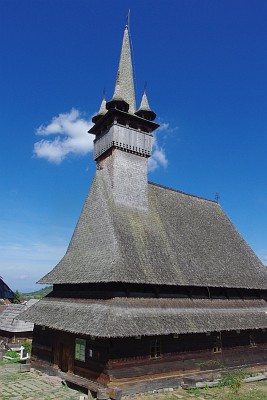
We had a big disappointment when we arrived in Budeşti and saw that the church (listed on the UNESCO world heritage list) was closed on Mondays with no number to call for the keys. We decided nevertheless to make a break there, so we sat on a bench in the surrounding graveyard and started to unpack our picnic when a young man walked up the hill to the church and after greeting us asked whether we would like to see its interior. Well… He smiled and explained that he had been on his way home when he saw us. Knowing that the church was closed he had then decided to go to the village hall and get the keys, just like that. We were really grateful for so much kindness and thanked him profusely. We had a very pleasant and interesting visit as he gave us many details about the church and its frescoes. Our friend's name was Georgi, he had lived in Belgium as a child, spoke a rusty French and was glad to be able to practice with Vero.
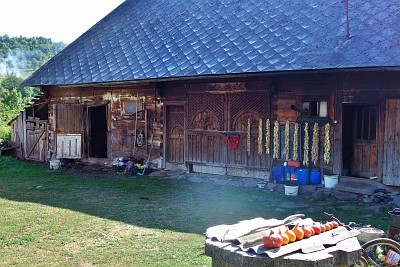 The second part of the walk was not so scenic as we walked along the river and had no panoramic views but it was very pleasant. Although many churches were closed, we stopped in every village to check them. We were rewarded for walking the extra mile to the Josani church in Călinesţi-Căeni which was a bit far from the main road: the key-keeper is living next to the church and alerted by her dogs she came to open the door for us so we could admire the impressive murals which are hidden inside. Most villages have usually two churches, the upper one (Susani) always sited on a slope, surrounded by a graveyard and overlooking the houses and the lower one (Josani) down in the village. We met elderly people caring for the graves or maintaining the green areas around the churches and it was nice walking through the villages, greeting the locals we saw as they worked in the fields or sat on their benches with a hearty “Bună ziua!”.
The second part of the walk was not so scenic as we walked along the river and had no panoramic views but it was very pleasant. Although many churches were closed, we stopped in every village to check them. We were rewarded for walking the extra mile to the Josani church in Călinesţi-Căeni which was a bit far from the main road: the key-keeper is living next to the church and alerted by her dogs she came to open the door for us so we could admire the impressive murals which are hidden inside. Most villages have usually two churches, the upper one (Susani) always sited on a slope, surrounded by a graveyard and overlooking the houses and the lower one (Josani) down in the village. We met elderly people caring for the graves or maintaining the green areas around the churches and it was nice walking through the villages, greeting the locals we saw as they worked in the fields or sat on their benches with a hearty “Bună ziua!”.
Many houses have a well in their front garden covered with a small roof, with a chain and a bucket ready for use. Some have carved wooden gates and others are sporting a black flag at their gates to indicate that its inhabitants are mourning the death of a relative who used to live in the house. In Călinesţi we could inspect an old water mill, formerly used for making flour and fulling wool and now renovated for touring visitors.
We walked until Corneşti and here again stood in front of a closed door. As time was advancing and traffic getting really low, we took this as a sign and decided to call it a day. We regained the road and started the walk back home, our thumbs in the air in the hope of getting a lift. We had to wait a while this time but we were eventually taken by a man and his son. They dropped us on the main road in Berbeşti where we swiftly found a second lift to Vadu Izei.
Although those two days felt idyllic and gave us the feeling of being in a time warp, it was obvious that reality is not as rosy as it seems. There are not a lot of jobs in the region and young adults have gone away in search of work in Western Europe, some of them leaving their children with the grand-parents in the hope of returning soon. They send as much money back home as they can and one can see new concrete houses taking shape behind or near the old wooden family houses. They look quite grand with big balconies and colonnades but most of them are work in progress: there is still a lot of money to be earned before they can add a new storey or start building the roof. The elderly have a big fear: that their children won't come back but settle in the West. They know that the probability of this happening is much higher if they take their children with them or start a family abroad. In fact, our host told us that some of those nearly finished houses are already up for sale, their owners having finally opted for a life in Western Europe…
Don't forget to check our photo gallery for more pictures of Maramureş and its wooden churches.
Want to read more? Go back to Trip Report and Budget or go on to Bucovina by Local Bus or go up to Blog
$ updated from: Blog.htxt Mon 28 Apr 2025 14:55:28 trvl2 — Copyright © 2025 Vero and Thomas Lauer unless otherwise stated | All rights reserved $




